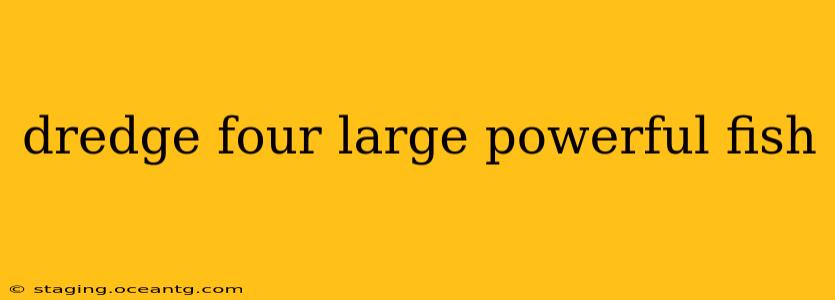Dredging Up the Big Ones: A Guide to Catching Four Large, Powerful Fish
Landing four large, powerful fish is a challenging but rewarding angling experience. It requires careful planning, specialized equipment, and a deep understanding of the target species and their habitats. This guide delves into the strategies, techniques, and considerations needed for success. We'll cover everything from choosing the right location to mastering the art of the fight.
What are some of the largest and most powerful fish species?
Several species stand out for their size and strength, making them prime targets for ambitious anglers. These include:
- Marlin: Known for their incredible speed and power, marlin are a prized catch for many. Blue marlin, especially, are giants of the ocean.
- Tuna: Various tuna species, such as bluefin and yellowfin, are renowned for their powerful runs and impressive size.
- Swordfish: Possessing a formidable sword-like bill, swordfish are strong fighters that can test even the most experienced angler's skills.
- Shark: Depending on location and regulations, several shark species present a thrilling challenge. Great whites, mako sharks, and hammerheads are among the most powerful.
- Giant Trevally: These impressive fish are found in tropical waters and put up a tremendous fight.
What is the best location to find these fish?
The best location depends heavily on the species you're targeting. Research is crucial. Consider these factors:
- Species-Specific Habitats: Blue marlin, for instance, are found in open ocean waters, while giant trevally might be found near reefs and structures. Understand the preferred habitat of your target.
- Seasonal Migrations: Many large fish species undertake seasonal migrations, influencing where they'll be found at different times of the year. Consult local fishing reports and guides.
- Water Temperature and Depth: Water temperature and depth play a vital role in determining fish distribution. Specific species thrive in specific temperature and depth ranges.
- Fishing Charters: Consider hiring a local charter captain experienced in targeting your chosen species. They possess valuable local knowledge.
What equipment is needed to catch such large fish?
Tackling large, powerful fish requires robust equipment:
- Rod: A heavy-duty rod specifically designed for big-game fishing is essential. The rod's strength and flexibility are crucial in absorbing the powerful runs of these fish.
- Reel: A high-capacity reel with a strong drag system is vital to manage the fish's power. Consider reels with multiple drag settings for fine-tuning pressure.
- Line: Strong braided fishing line with a high breaking strength is crucial to handle the strain of a powerful fish. The line diameter should be appropriate for the size of the rod and reel.
- Hooks and Lures: Strong, sharp hooks are necessary, along with lures designed to attract your target species. Consider the size and type of lure based on the fish you are pursuing.
- Fighting Gear: A harness and fighting belt distribute the strain across your body during a prolonged fight.
What techniques are used to catch these large fish?
Catching large, powerful fish relies on skill and technique:
- Trolling: Trolling lures behind a moving boat is effective for covering vast areas and enticing fish to strike.
- Jigging: Using heavy jigs to attract fish from the depths requires strength and precision.
- Baiting: Employing live or dead bait can be highly effective for attracting a wide range of species.
- Knowing When to Fight and When to Give Line: The fight is a delicate balance of applying pressure while also giving line to prevent breakage and exhaustion.
- Proper Hook Setting and Fighting Techniques: A sharp hook set is vital, as is knowing how to effectively fight the fish to minimize the risk of line breakage or hook loss.
What are the best fishing practices to protect these powerful fish?
Responsible fishing practices are crucial to ensure the sustainability of these magnificent creatures:
- Catch and Release: Consider practicing catch and release whenever possible, using appropriate techniques to minimize harm to the fish.
- Respecting Size and Bag Limits: Adhere to local regulations regarding size and bag limits to ensure sustainable fishing practices.
- Using Barbless Hooks: Barbless hooks make it easier to release fish with minimal injury.
- Proper Handling: Handle fish carefully to minimize stress and ensure their survival if released.
By understanding the specific requirements for targeting and catching large, powerful fish, you can significantly improve your chances of success while acting as a responsible and ethical angler. Remember that safety and responsible fishing practices are paramount.
